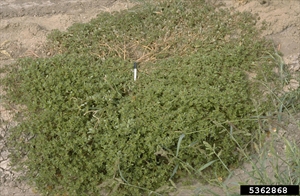- Widespread. Asia, Africa, North, South and Central America, Caribbean, Europe, Oceania. In Australia, FSM, Fiji, New Zealand, PNG.
- Aggressive weed of vegetables, grain and plantation crops, pastures, disturbed sites, waste areas, footpaths and roadsides. Invasiveness assisted by rapid growth in variety of soils, early flowering, huge seed production, survival in soil for several years, germinating rapidly following ploughing in responses to light. Also, drought tolerant. Alternative host of nematode, virus and phytoplasma pathogens.
- Much-branched, creeping, fleshy stem, 20-50 cm long, reddish, hairless. Leaves, alternate along stems, 5-25 mm long, hairless, wedge-shaped, without stalks (or very short). Flowers, yellow, single or in small clusters, in forks of leaves, each with 4-6 petals. Fruits contain small black seeds, glossy, warty.
- Spread: seed; by birds; wind, water; contaminant of crop seeds.
- Biosecurity: moderately high risk of introduction; contaminant of seed.
- Biocontrol: weevil, Hypurus bertrandi, introduced into Hawaii, but present status unreported.
- Cultural control: hand weed or hoe; thick mulch.
- Chemical control: in Australia: 2,4-D; diuron; dicamba; MCPA; metsulfuron-methyl; metribuzin; pendimethalin; propyzamide; fluroxpyr; trifluralin; glyphosate (and Fiji); oxyfluorfen.






